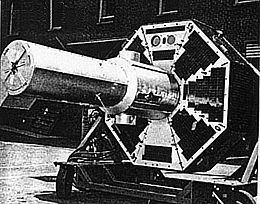Mission type Technology COSPAR ID 1967-066F Mission duration 3 years Inclination 11.6° Launch mass 200 kg Rocket Titan IIIC | Operator NASA / USAF SATCAT no. 2867 Launch date 1 July 1967 Inclination 11.6° Launch mass 200 kg | |
 | ||
Dimensions 2.4 by 1.2 metres (7.9 by 4.0 ft) Manufacturers Johns Hopkins University, Applied Physics Laboratory | ||
DODGE (Department of Defense Gravity Experiment) was a satellite whose primary purpose was to conduct experiments in gravity-gradient stabilization at near-geosynchronous altitudes. Its secondary objectives included measuring the Earth's magnetic field, and taking pictures of the entire Earth's disk in both black-and-white and color. It was launched atop a Titan IIIC rocket on July 1st, 1967 and operated for over three years. DODGE carried ten knobbed booms oriented along three different axes, that could be independently extended and retracted by ground command.
DODGE first achieved successful stabilization 12 days after launch, and took one of the first color pictures of the complete Earth disk.
References
DODGE (satellite) Wikipedia(Text) CC BY-SA
